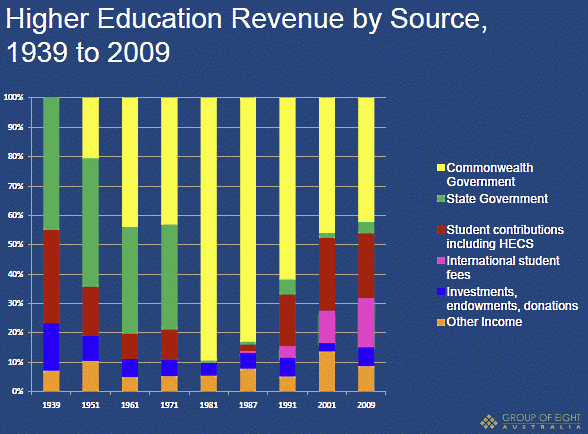|
|
|
|
|
|
|
News & Views item - July 2011 |
![]() Go8 Announces Pilot of In-House Quality Assessment and Outlines Options for the
Base Funding Review. (July 4, 2011)
Go8 Announces Pilot of In-House Quality Assessment and Outlines Options for the
Base Funding Review. (July 4, 2011)
The Group of Eight (Go8) has announced that it is to undertake a pilot program of what it terms a Quality Verification System (QVS) in the remaining half year.
In its July newsletter it states:
The QVS is a process of
external, discipline-led, academic peer review of final year undergraduate
student outcomes. The primary focus is to assist Go8 universities in maintaining
and improving their academic standards.
All Go8 member universities
are participating in the pilot which will cover the fields of Education:
Physics, History, Psychology, Accounting and Chemistry.
The key features of the Go8
QVS include:
a focus on assessment in
a sample of final year subjects in undergraduate programs;
benchmarking for
comparing grades awarded in similar programs across Go8 universities;
senior
discipline-specific academics will conduct the review and will have an
understanding of academic standards in similar universities around the
world; and
flexibility to complement
other quality assurance mechanisms within Go8 universities.
The QVS will verify the awarding of grades within Go8 universities and will promote discussion on best practice in teaching and learning across institutions and improve cross institutional understanding. Reviewers can be drawn from other Australian universities (including other Go8 universities) or international visitors from overseas institutions of similar standing.
The QVS will provide public assurance and confidence that learning outcomes in Go8 universities are comparable across grades and in line with world leading universities.
The Go8 promises to provide addition information on the workings of the Quality Verification System in the near future. Just how it is to be coordinated with the federal government's Tertiary Education Quality and Standards Agency (TEQSA) if at all hasn't been enunciated as yet.
_____________________________________________

With regard to the Go8's assessment of options for the base
funding review its executive director, Michael Gallagher, made a
detailed presentation![]() to the Financial Review Higher Education Conference, in Sydney last Tuesday,
which however carried the caveat: "The views expressed in this address do not
necessarily represent the views of Go8 Vice-Chancellors."
to the Financial Review Higher Education Conference, in Sydney last Tuesday,
which however carried the caveat: "The views expressed in this address do not
necessarily represent the views of Go8 Vice-Chancellors."
Below is the summary provided in the Go8's July newsletter of what Mr Gallagher had to say in his address which he titled: Muddling through the labyrinth to a vision, or a wall, or a fall? What remains to be seen is just what will be decoded as regards the best distribution of resources to enhance the overall quality of research and learning required by the nation. As has been recently noted, too narrow a focus of resources will lead to an unstable situation that will benefit no one.
In an open demand-driven higher education system, a
segmented approach to funding would make more cost-effective use of taxpayers’
and students’ funds, and it would stimulate greater diversity and innovation in
Australian higher education. It would involve a lower government payment per
place to non-research Higher Education Providers (HEPs) and greater choice for
students in the prices they pay. It would enhance funding and quality in those
areas where research and research-based higher education can be provided.
A number of policy possibilities present themselves.
1. One option is to differentiate the funding rate per
student place for universities from that for other HEPs that do not
perform research, whether TAFE colleges or private providers. This would promote
the expansion of pre-Bachelor as well as Bachelor degree offerings, give
learners more options and give VET providers a fairer chance to compete for
students. The TEQSA legislation recognises the special status of universities as
self-accrediting institutions. The provider category standards developed for
TEQSA require universities of whatever type to undertake some research. It would
be consistent with those policy features, and with long-held understandings in
the Australian policy space, to adhere to the principle that a university should
be funded for research only where it is performing research, and only where its
research performance is of acceptable quality, such as that assessed through ERA
at world average standard or better. Similarly, universities should be funded or
licensed to offer PhD programs only in those areas where they are doing quality
research.
2. Another option is to enhance the funding for research by providing for
principal investigator salaries to be paid by research funding councils, and by
increasing the block grant for deep infrastructure. The general research
activity of universities, not funded through research grants, will need to be
sustained through an IGS-like program that has regard for student load and
teacher-researcher numbers and their infrastructure requirements.
3. A third option is to include a community service component in the envelope
for university funding compacts. Some provision for continuity of scholarship in
fields of study prone to volatility of student demand could also be negotiated
through the compacts.
Some combination of these options may be possible without adding to complexity. The advantages of an approach along these lines are:
enabling the base of participation to expand cost-effectively while not diluting quality at the top; and
allowing Australia to be a leading player in the next phase of global higher education.
